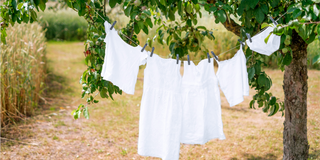白の衣類を最高の見た目と感触に保つのは、特に何度も着用したり洗濯したりした場合には、難しい場合があります。毎日の着用、不適切な布地の手入れ方法、環境などが、衣類の黄ばみや汚れを引き起こし、くすんで見えたり、使い古されたように見えたりする主な要因です。
幸いなことに、強い化学薬品に頼らずに白い布地の本来の輝きを取り戻す方法はたくさんあります。専門家のヒントと適切な洗濯ケア製品があれば、ワードローブをいつでも準備して、いつものように明るく輝かせることができます。
なぜ布地は汚れてしまうのでしょうか?
解決策を検討する前に、まず生地の光沢が失われる理由を理解することが重要です。生地が変色する一般的な原因としては、体油、洗剤の蓄積、環境への曝露、有効成分を含む消臭剤の使用、刺激の強い化学薬品、不適切な洗濯方法などが挙げられます。
過度の汗や汚れが衣服に蓄積すると、特に襟、脇の下、袖口など摩耗しやすい部分が黄ばんでしまいます。体内で生成される天然オイルがデオドラントや制汗剤の有効成分と反応し、衣服に黄色いシミが付くことがあります。
洗濯機に洗剤を入れすぎると、衣類がきれいになると思ってしまう人もいますが、実際にはしばらくすると生地が灰色や汚れた感じになってしまいます。洗剤が蓄積すると生地が過度に摩耗し、毛玉ができてしまいます。
衣服が変色するもう一つの原因は、日光、汚染物質、さらには硬水への長時間の露出です。水温、乾燥方法、強力な洗剤の使用が間違っていると、白い衣服が色あせてしまうことがあります。
最後に、塩素系漂白剤などの強力な化学薬品を使用すると、特に綿製の衣類が黄ばんでしまいます。環境に優しい洗濯用粉末洗剤と専門家のヒントを活用すれば、汚れや黄ばみの原因を防ぐことができます。
オプション1: 衣類を事前に浸す
洗濯をする前に、白い衣類はすべてぬるま湯に 3 ~ 4 時間浸けておく習慣をつけましょう。確かに、余分な手間と手間はかかりますが、最終的な仕上がりはずっと良くなります。そうするだけで、衣類に付着したほとんどの体脂、汗、洗剤や汚れが取り除かれます。軽い汚れがあれば、それも落ちます。
オプション2: レモンジュースまたは蒸留酢を使用する
白い衣類にひどいシミや黄ばみがある場合は、ぬるま湯の入った浴槽にレモン汁または蒸留酢を数滴垂らし、衣類を少なくとも 3 ~ 4 時間浸します。必要に応じて、希望する結果が得られるまでこのプロセスを数日間繰り返します。
オプション3: 自然な漂白のために日光を使用する
お気に入りの衣類に有毒な塩素系漂白剤を使用する代わりに、生地を直射日光の下に干すだけです。日光に含まれる紫外線は天然の漂白剤として作用し、余分な化学薬品を使わずに衣類をより明るく白く見せます。黄ばみがひどい場合は、衣類が完全に復活するまで数日間この手順を繰り返します。
オプション4: 生地の毛玉を確認する
場合によっては、白い生地が糸くずや毛玉のせいで灰色や汚れに見え始めることがあります。これらの厄介な小さな繊維の玉は、衣類の外観と耐久性に悪影響を及ぼし、着古したように見え、着心地も悪くなります。
この問題を解決するには、BIORESTORE Re-Tergent のような環境に優しい洗濯用粉末洗剤の使用を検討してください。たった 1 回の洗濯で毛玉が取り除かれ、綿生地は余分な手間をかけずに元の鮮やかさと手触りに戻ります。
オプション5: ブルーイングを追加する
ブルーイングとは、白い衣類を洗うときに水に加える着色剤です。白い衣類の黄色みを中和し、より明るく見せます。白い衣類を何度も着用して洗濯している場合は、洗濯のときにブルーイングを加えると、真っ白な輝きが長持ちします。
トップローディング式の洗濯機では、衣類を洗濯機に入れる前に洗剤を入れるときに、ブルーイング剤を数滴加えることができます。そうでない場合は、すすぎのときにブルーイング剤を加えることもできますが、この時点で衣類がすでに洗濯機の中に入っているため、青いシミができるリスクが高くなります。
手洗いの場合は、ブルーイング剤が水に均等かつ完全に混ざっていることを確認してください。万が一、衣類に青い筋が付いてしまったとしても、洗濯の失敗ではなく、単に気になる程度です。これらは簡単に洗い流せます。
白い衣類の黄ばみや汚れを防ぐ
白い布地が黄ばんだり汚れたりするのを防ぐには、まず衣類にシミがつかないようにすることから始めましょう。たとえば、お子さんの衣類に食べ物のシミがたくさんついてしまったら、ナプキンをあげましょう。ナプキンを「かっこいいもの」として着たり、「流行」として追ったりしましょう。そうしないと、みんなが大好きな赤いソースのパスタが洗濯の日に大惨事を引き起こすことになります。
塩素系漂白剤は、デリケートで上質な衣類に有害な化学物質が詰まっているので、使用しないでください。漂白しすぎると、白い綿の生地が永久に黄ばんでしまうことさえあります。洗濯するたびに、加えられた光学染料が徐々に剥がれ落ちてしまうからです。どうしても白い衣類に漂白剤を使用しなければならない場合 (しつこいシミや黄ばみがひどい場合) は、使用前に必ず薄めるか、衣類の処理には「非塩素系」の代替品を選んでください。
毒性のある成分や刺激の強い化学物質を含まない、環境に優しい洗濯用粉末洗剤を使用してください。衣類用の洗剤を購入する際は、「無毒」、「漂白剤不使用」、「リン酸塩不使用」、「環境に優しい」、「優しい」などのラベルを探してください。液体洗剤も、粉末洗剤よりも一般的にマイルドなので、優れた選択肢です。
最後に、衣類がひどく汚れていたり、汗が大量に溜まっている場合を除き、洗濯に熱湯を使うのは避けてください。これは、 衣類の寿命を延ばすのに役立つだけでなく、洗濯中に消費される電力のほとんどが水の加熱プロセスに起因するため、より持続可能でもあります。
これらの簡単な布地のお手入れのヒントに従うことで、お気に入りの白い衣類をより長く、より明るく白く保つことができます。





